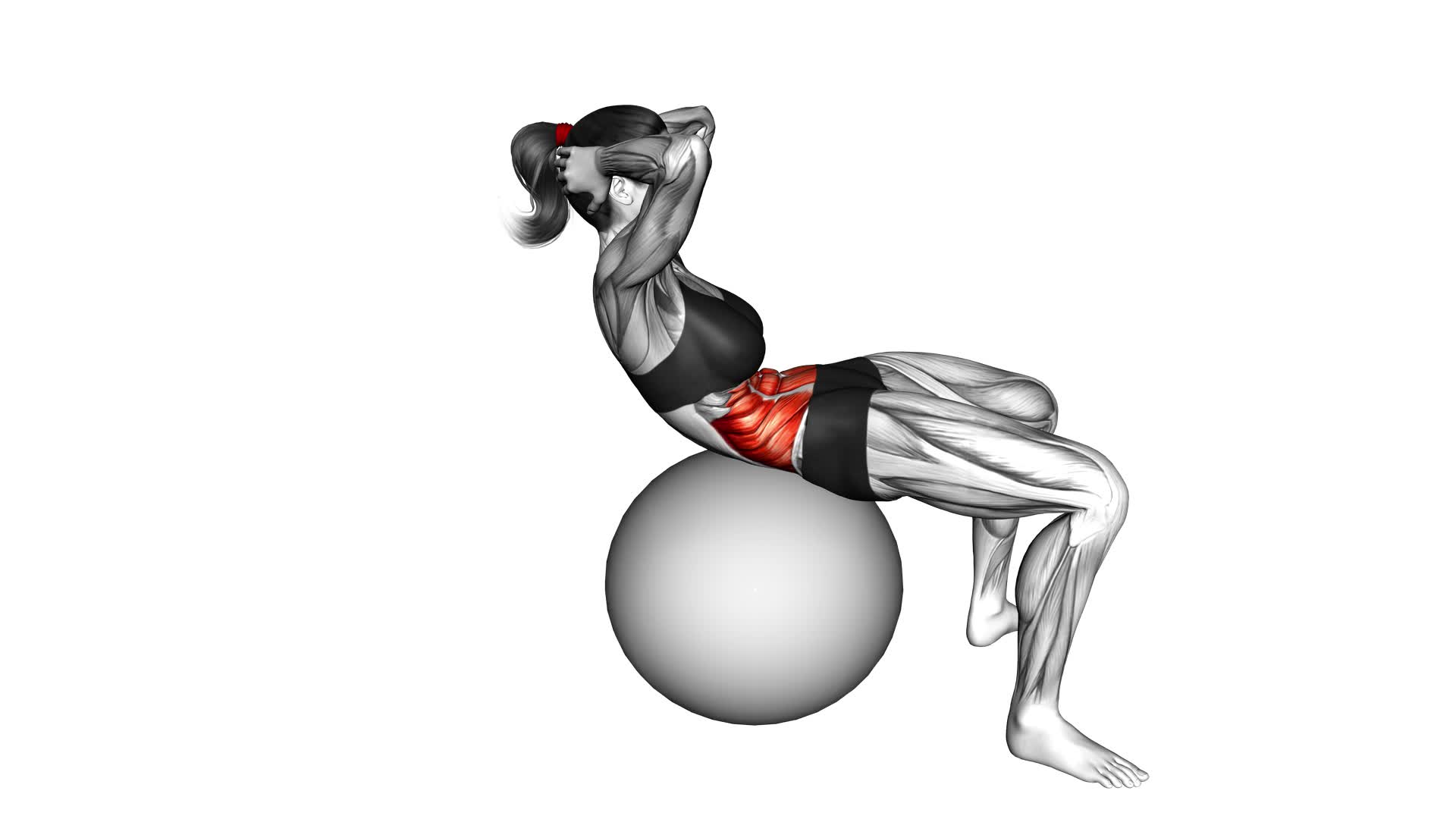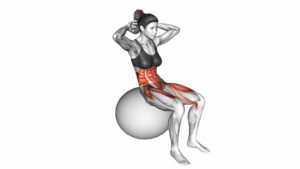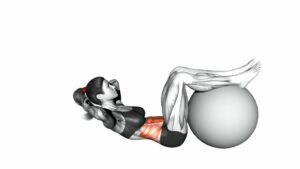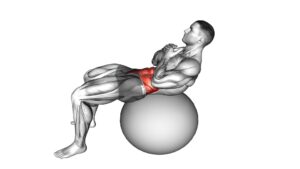Crunch (On Stability Ball) (Female) – Video Exercise Guide & Tips

Looking to strengthen your core?
Watch This Exercise Video
In this video exercise guide, you'll learn how to do the Crunch on a stability ball.
This challenging move targets your abs and improves stability.
Watch as a female fitness expert demonstrates proper form and technique.
Plus, get tips on variations, progressions, and common mistakes to avoid.
Maximize your workout with this effective exercise that will leave your core feeling stronger than ever.
Key Takeaways
- Crunch (On Stability Ball) targets core muscles, including abs and obliques.
- It engages stabilizer muscles for enhanced stability and balance.
- Crunch (On Stability Ball) reduces strain on the neck and lower back.
- Proper form and technique are essential to reduce the risk of injuries.
Benefits of Crunch (On Stability Ball) Exercise
Experience the amazing benefits of the Crunch (On Stability Ball) exercise as it strengthens your core muscles and improves stability. This exercise has numerous advantages that make it an effective addition to your fitness routine.
The Crunch (On Stability Ball) exercise is highly effective in targeting your core muscles, including the abs and obliques. By performing crunches on a stability ball, you increase the activation of these muscles, resulting in a more intense workout. The instability of the ball also engages your stabilizer muscles, enhancing overall stability and balance.
One of the key advantages of the Crunch (On Stability Ball) exercise is its ability to reduce strain on your neck and lower back. Unlike traditional crunches performed on the floor, the stability ball provides support and cushioning, minimizing the risk of injury and discomfort.
In addition to its core-strengthening benefits, the Crunch (On Stability Ball) exercise also helps improve posture. By working the muscles that support your spine, this exercise promotes proper alignment and reduces the likelihood of back pain.
To maximize the effectiveness of the Crunch (On Stability Ball) exercise, it's important to maintain proper form and technique. Focus on contracting your abdominal muscles as you curl your upper body off the ball, while keeping your lower back pressed against the ball for stability.
Proper Form and Technique for Crunch (On Stability Ball)
Do you know how to properly perform the Crunch (On Stability Ball) exercise to maximize its benefits and avoid injury? It's important to understand the proper form and technique for this exercise in order to get the most out of it.
One common misconception is that the stability ball is just for support, but it actually adds an extra element of challenge and instability to the exercise. When performing the Crunch on a stability ball, start by sitting on the ball with your feet flat on the floor. Walk your feet forward as you roll your back onto the ball, so that your lower back is supported.
Place your hands behind your head, keeping your elbows wide. Then, engage your core muscles and lift your upper body towards your thighs, keeping your neck and shoulders relaxed. Exhale as you crunch and inhale as you return to the starting position. Remember to maintain control throughout the movement and avoid any jerking or swinging motions.
By using the proper equipment for the Crunch on a stability ball and following the correct form and technique, you can effectively target your abdominal muscles and improve your core strength.
Transitioning into the subsequent section about variations and progressions for the Crunch on a stability ball, let's explore how you can further challenge yourself and continue to progress in this exercise.
Variations and Progressions for Crunch (On Stability Ball)
To further challenge yourself and continue progressing in the Crunch (On Stability Ball) exercise, try incorporating different variations and progressions. By adding variety to your workouts, you can prevent boredom and keep your muscles guessing. Here are some options to consider:
- Weighted Crunches: Hold a dumbbell or a medicine ball against your chest while performing the crunches on the stability ball. This will increase the resistance and make the exercise more challenging.
- Oblique Crunches: Instead of performing the crunches straight up, twist your torso to one side as you crunch up. This targets the oblique muscles on the sides of your abdomen.
- Reverse Crunches: Start by lying on the stability ball with your hands supporting your head. Instead of crunching up, lift your hips off the ball while keeping your upper body stable. This targets the lower abs.
- Single-Leg Crunches: Lift one leg off the ground and keep it extended as you perform the crunches. This adds an extra stability challenge and engages your core muscles even more.
These advanced modifications will help you take your stability ball crunches to the next level. Remember to always maintain proper form and listen to your body. Happy crunching!
Common Mistakes to Avoid During Crunch (On Stability Ball)
When performing Crunches (On Stability Ball), it's important to be aware of common mistakes that should be avoided for proper form and effectiveness. By avoiding these mistakes, you can reduce the risk of injuries and ensure that you're getting the most out of your workout. Here are four common mistakes to avoid during Crunches (On Stability Ball):
- Using momentum: It's important to perform the movement in a controlled manner, using your abdominal muscles to lift your upper body off the ball. Avoid using momentum or swinging your body to complete the crunch, as this can decrease the effectiveness of the exercise and put strain on your lower back.
- Holding your breath: Proper breathing techniques are essential during Crunches (On Stability Ball). Exhale as you lift your upper body off the ball and contract your abs, and inhale as you lower yourself back down. Holding your breath can cause unnecessary tension and strain.
- Placing your hands behind your head: Instead of placing your hands behind your head, place them lightly on the sides of your head or across your chest. Placing your hands behind your head can lead to pulling on your neck, increasing the risk of neck strain or injury.
- Not engaging your core: To maximize the effectiveness of the exercise and avoid injuries, make sure to engage your core throughout the movement. Imagine pulling your belly button towards your spine and focus on contracting your abdominal muscles.
By avoiding these common mistakes, you can perform Crunches (On Stability Ball) with proper form and technique, reducing the risk of injuries and maximizing the benefits of the exercise.
Now, let's move on to the next section to learn some tips for getting the most out of your crunch (on stability ball) workout.
Tips for Getting the Most Out of Your Crunch (On Stability Ball) Workout
To maximize the effectiveness of your Crunches (On Stability Ball) workout, focus on maintaining proper form and technique throughout the exercise. This will help you maximize results and get the most out of your workout.
First, make sure you're positioned correctly on the stability ball. Place your lower back on the ball, your feet flat on the ground, and your knees bent at a 90-degree angle. This will ensure that you engage the right muscles and maintain stability throughout the exercise.
When performing the crunch, keep your core muscles engaged and your lower back pressed against the stability ball. This will help you target your abdominal muscles and prevent strain on your lower back. As you crunch up, exhale and contract your abs, making sure to lift your shoulder blades off the ball. Avoid pulling on your neck or using momentum to lift your upper body. Instead, focus on using your abdominal muscles to lift and lower your upper body.
To further maximize the results of your crunches on the stability ball, consider incorporating the stability ball into other exercises. For example, you can use the stability ball to perform exercises like planks, push-ups, and leg raises. This will challenge your core muscles even more and help you build strength and stability throughout your entire body.
Frequently Asked Questions
How Many Calories Can You Burn by Doing Crunches on a Stability Ball?
You can burn calories and get an effective abdominal workout by doing crunches on a stability ball.
The stability ball adds an element of instability, which engages your core muscles even more than traditional crunches.
This increased muscle activation leads to more calorie burning during your workout.
Plus, the stability ball allows for a greater range of motion, targeting your abs from different angles.
Can Crunches on a Stability Ball Help With Post-Pregnancy Belly Fat?
Crunches on a stability ball for post-pregnancy belly fat: effective or not?
Can they reduce waist circumference after pregnancy?
Yes, crunches on a stability ball can be a helpful exercise to target and tone the abdominal muscles, including the post-pregnancy belly.
By engaging the core and promoting muscle strength, these crunches can contribute to reducing waist circumference over time.
However, it's important to remember that a comprehensive approach, including a balanced diet and overall fitness routine, is key for optimal results.
Is It Safe to Do Crunches on a Stability Ball if You Have Lower Back Pain?
If you're dealing with lower back pain, doing crunches on a stability ball may not be safe. Safety precautions should be taken when it comes to exercising with any kind of pain.
It's important to listen to your body and avoid any movements that aggravate your condition. Instead, try alternative exercises that target your core without putting strain on your lower back, such as planks or bird dogs.
Always consult with a healthcare professional before starting any new exercise routine.
Can Crunches on a Stability Ball Help Improve Balance and Stability?
Crunches on a stability ball can indeed help improve balance and stability. By engaging your core muscles, these exercises not only strengthen your abs but also increase flexibility.
The unstable surface of the stability ball challenges your body to maintain stability, enhancing your balance and coordination. Incorporating crunches on a stability ball into your workout routine can be an effective way to improve your overall stability and core strength.
How Often Should Crunches on a Stability Ball Be Performed to See Results?
To see results from crunches on a stability ball, you need to perform them at the right frequency. The best time to do crunches is every other day, allowing your muscles time to rest and recover.
Consistency is key, so aim for at least three times a week. Start with a manageable number of reps and gradually increase as you get stronger.
Keep in mind that proper form is crucial for effectiveness and preventing injury.
Conclusion
In conclusion, the Crunch (On Stability Ball) exercise is a highly beneficial and effective way to strengthen your core muscles.
By maintaining proper form and technique, you can maximize the results of this exercise.
Additionally, incorporating variations and progressions can help to continuously challenge your muscles and prevent plateaus.
Avoiding common mistakes and following the provided tips will ensure you get the most out of your Crunch (On Stability Ball) workout.
So grab a stability ball and start crunching for a stronger core.

Author
Years ago, the spark of my life’s passion ignited in my mind the moment I stepped into the local gym for the first time. The inaugural bead of perspiration, the initial endeavor, the very first surge of endorphins, and a sense of pride that washed over me post-workout marked the beginning of my deep-seated interest in strength sports, fitness, and sports nutrition. This very curiosity blossomed rapidly into a profound fascination, propelling me to earn a Master’s degree in Physical Education from the Academy of Physical Education in Krakow, followed by a Sports Manager diploma from the Jagiellonian University. My journey of growth led me to gain more specialized qualifications, such as being a certified personal trainer with a focus on sports dietetics, a lifeguard, and an instructor for wellness and corrective gymnastics. Theoretical knowledge paired seamlessly with practical experience, reinforcing my belief that the transformation of individuals under my guidance was also a reflection of my personal growth. This belief holds true even today. Each day, I strive to push the boundaries and explore new realms. These realms gently elevate me to greater heights. The unique combination of passion for my field and the continuous quest for growth fuels my drive to break new ground.



